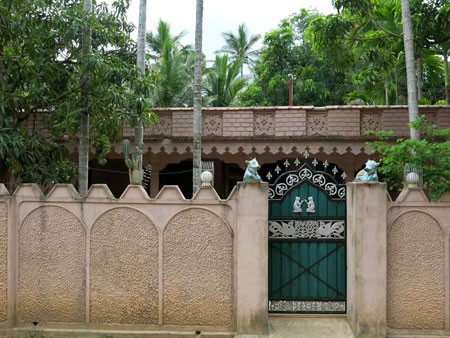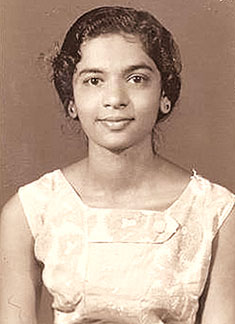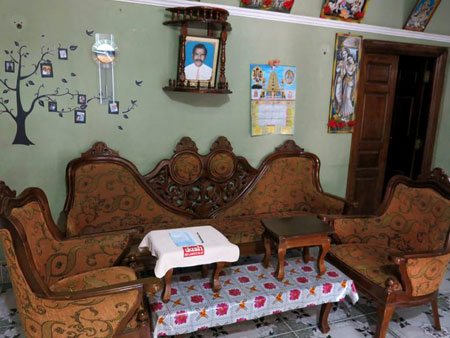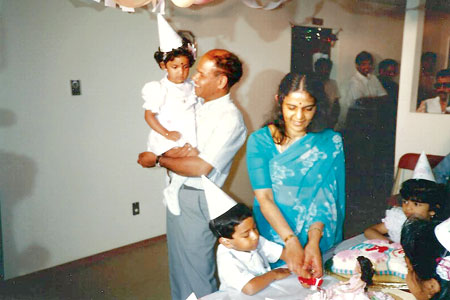Seeking the place my father once called home
by Dakshana Bascaramurty
|

Theivam PathyĒ: My dadís childhood home in Atchuvely. |
My father never read to me when I was a kid, but could sometimes be
persuaded to tell a bedtime story from memory, drawn from a stock of Sri
Lanka-ified versions of Aesop's Fables.
In the original parable of the crow and the fox, the fox flatters the
crow, who is holding a piece of cheese in his beak, into singing for
him. This prompts the crow to drop the cheese, and the fox catches it.
My dad's version was pretty close to Aesop's original, except that the
hunk of cheese was actually a vadai.
A crow eating vadai. To a five-year-old growing up in suburban north
Toronto, this was an absurd image, and one I added to a patchwork of
others in an attempt to understand Sri Lanka, where my parents were from
but rarely spoke to me about. I understood a rough outline of why they
and many other Tamils had left their troubled country and made Canada
their home. I know their history in a meta sense, but few of the
details.
Dad's silence
My dad's life, especially, was a mystery. Although my parents spoke
Tamil in the house, enrolled me in bharatanatyam classes as a child, and
made regular pilgrimages to a Hindu temple near Pittsburgh, the only
tangible evidence of my dad's life in Sri Lanka were a few wallet-sized
black-and-white portraits that had been preserved in yellowed envelopes
or stuck into the crook of a disintegrating photo album.
The younger version of him looked nothing like the man I knew. Who
was this stern-faced stranger whose jaw was narrower, lips were plumper
and hair was more lush than that of my father, 46 and half-bald when I
was born? Was he good at sports, or a klutz like me? What did his
bedroom look like? His neighbourhood? How did he get to school every
day, and did it look more like mine or the one on Little House on the
Prairie?
|

My mother Saro, in Jaffna. |
How far removed from my world was his, on that mango-shaped island
surrounded by the Indian Ocean nearly 14,000 kilometres away?
My dad never responded to my probing questions in a satisfying way.
Like so many of those who even now are heading to Canada in the hope of
a better life, he looked forward rather than behind.
When I was in grade school, there was wistful talk of a possible
family trip there one day, but it never materialised. The enormous
expense was one obstacle, safety a much bigger one. Government forces,
representing the Sinhalese majority, had been at war with the separatist
Liberation Tigers of Tamil Eelam (LTTE) since before I was born.
By the time the war ended, in 2009, my brother and I were working
adults, living thousands of kilometres away from our parents. Sri Lanka
faded off my list of travel destinations. Maybe I'd never see it, and
maybe that was okay.
In my parent's homeland
Then, this fall, I found myself in my parents' homeland for the first
time - without them.
My husband, Anis, is half Sri Lankan and has family in the country's
south. His cousin Tamarih was getting married this past October, and so
we booked a two-week trip to the country. My long-buried interest in my
so-called homeland was suddenly awakened - not least because the last
leg of our trip would be a three-day sojourn to the North, organised by
Anis's mother. My dad's house became the prime destination of the
journey: In finding it, I hoped to understand him better.
My parents left Jaffna many years before the civil war began in 1983.
In the late eighties, as the hostilities intensified, my grandparents,
aunts and uncles began arriving in Canada, some sponsored by family,
others claiming refugee status.
At one point, before I was born, there were seven members of the clan
squeezed into my parents' two-bedroom apartment in Toronto's High Park
neighbourhood.
Today, according to Statistics Canada, 131,000 Tamils live in Canada;
academic experts put the figure even higher, at close to 200,000. So
many settled in the Toronto suburb of Scarborough - opening up an
extensive network of shops that sell 22-carat-yellow-gold wedding
jewellery or imported spices - that some affectionately call it Little
Jaffna.
Before the war, before the outflow, my dad recently confessed, he had
fantasised about returning to his farming village of Atchuvely. Soon
after he married, he suggested this plan to my mom, and she agreed to
it.
|

Inside the house. |
"When Sri Lanka was in good shape, it was pointless wasting your time
in another country," he recently told me, though, as usual, he held back
on any details about why his homeland was so great. Although years ago
he made one short trip back to Sri Lanka, his plans to settle in
Atchuvely never materialized.
My mother's history
My mother was only slightly more forthcoming than my dad when it came
to her history. One of the few bones she ever threw me was the story of
how her father was almost killed by the Sri Lankan Army a few years
after my parents came to Canada.
Having heard that soldiers were on the way to Urelu, their village,
my grandfather had hid the family down the road. When he sneaked back
later in the day to feed the guard dog, three troopers stormed into the
house. It didn't take long before they found him - hiding, rather
comically, under a pile of burlap sacks.
Two of them pointed guns in his face while another brandished a
knife. He pleaded for mercy, and they let him go - but set the house
ablaze. With the help of neighbours, my grandfather drew water from the
well to put out the flames. Soon after that episode, he and my
grandmother moved to Toronto, living with my parents until they found an
apartment of their own. While downtown Colombo is a 21st-century city,
history seems to have pressed pause on Jaffna. In the 10 days before
arriving there, we'd travelled from the hubbub of Colombo to the tidy
Portuguese-built streets of Galle, from Kandy's steep hills to the tea
plantations of Nuwara Eliya. But the area in and around Jaffna was by
far the most primitive part of the country.
The Sri Lankan Government has spent serious capital on reconstruction
here since 2009, but signs that this was the site of a protracted
conflict were tattooed on the land. We passed the
half-empty shells of bombed houses, some covered with vines that had
twisted around their crumbling facades. It was clear that making Jaffna
whole again will take far more time and money.
Subhas in Urelu
It was only after much prodding that I had finally got my parents to
help co-ordinate a list of places to seek out during my time in the
North. They were pleased with the idea of my going to Sri Lanka, but
didn't exhibit the glee I'd hoped for when I mentioned the journey to
Jaffna.
|

My motherís childhood home in Urelu in 1985, after it was
raided by the Sri Lankan army and set ablaze. |
It was my Australian uncle, Yogan Mama - my mother's brother - who
did the heavy lifting, spending hours poking around on Google Satellite
and compiling points of interest in Urelu. Was the village co-op store
still there, he wondered? It was where members bearing ration books
could pick up weekly allotments of sugar, flour, rice, semolina and
Maldive fish.
When the family had dinner guests, my uncle recalled, one of the four
brothers would be sent off into town to Subhas, Jaffna's first ice-cream
parlour. Whoever was dispatched would fill a flask with vanilla, the
only flavour available, and cycle home from the relative hubbub of
Jaffna's town centre to the sleepy village where the family grew
bananas, coconuts, guava and eggplants. The owners of Subhas also ran a
famous hotel of the same name that was shuttered for many years because
of the war.
The hotel has reopened, but the ice-cream parlour, we discovered as
we poked around, is long gone. So were the snack corners where they'd
order rotis and mutton korma for lunch, and the grinding mill where
they'd take coffee, rice and lentils for processing.
In my dad's village, meanwhile, his primary school was still
standing, but the fate of many others, including both of the secondary
schools he attended, was a mystery.
As I set out with Anis and a few members of his family, I had little
optimism we would find what we were looking for here.
Once the second-largest city in Sri Lanka, Jaffna had been hollowed
out by the war, and now has a population smaller than it did half a
century ago. As we drove through this city, with its broken
infrastructure and overhauled population, it seemed like a long shot
that I'd find the place where my dad had grown up, or any traces of my
parents' former lives, for that matter.
The directions my family had offered to my father's childhood home in
the village of Atchuvely were simple: We were to look for a temple built
to honour Pillayar (the elephant god, also known as Ganesh) and, after
finding it, to ask around for the house known as Theivam Pathy.
During the war, a few temples were destroyed; others were occupied by
the army so Hindus couldn't pray at them. Since the end of the conflict,
some houses of worship had been rebuilt, occasionally funded by former
residents who had created lives elsewhere. If we couldn't find the first
landmark, there was little hope. But the Pillayar Temple was there!
An L-shaped structure painted mustard, it reminded me more of a
repurposed farmhouse than the majestic white buildings adorned with
hand-carved deities we'd seen in other parts of the country.
Finally found it
Save for a few smartly uniformed children playing behind the gate at
my dad's old school, there was no sign of a living soul. We'd made the
mistake of showing up during Atchuvely's unofficial nap time.
Just as we were about to throw in the towel, my husband spotted a man
in the distance driving toward the temple on a scooter, and we waved him
over.
"I'm looking for a house called Theivam Pathy. Know it?" I asked in
my rusty Tamil.
"Theivam Pathy," the man said slowly, letting the words marinate on
his tongue for a few seconds.
My dad was born in 1939, the same year The Wizard of Oz was released
in theatres, an odd fact I always held onto because he was so rarely
forthcoming with biographical details.
And so it somehow seemed fitting that, in this journey to learn more
about his life, I had crossed paths with people who brought to mind the
benevolent residents of Munchkinland.
A shirtless, white-haired man in a veshti (a white cotton sarong)
held up with a belt, his cellphone tucked between the layered fabric and
his belly, walked to the gate of a nearby house, eyeing us with what
seemed to be curiosity and suspicion, as if we were Martians. His wife,
a wiry woman with sharp cheekbones, marched up with him, sporting a
faded green cotton dress and a dot of red kungumam on her forehead.
"I'm a visitor from Canada," I began, with a broken Tamil. "My father
used to live here and I'm looking for his house. Do you know Theivam
Pathy?" I asked.
The woman's eyes lit up immediately. "Theivam Pathy? Oh yeah, I know
Theivam Pathy!"
The group at this house now wandered over to the one next door, where
another shirtless man confirmed that Theivam Pathy was just down the
road.
"Just around the corner" means as little in Sri Lanka as it does in
Canada. We rounded many corners, trailing the man in the baseball cap
for what felt like 15 minutes, until he gestured at a house.
|

My father holds me up on my third birthday in 1989. |
|

My mother (far left), with three of her sisters at the
family home in Urelu, a village near Jaffna in the 1960s or
1970s. |
Here it was: a modest bungalow surrounded by a stucco wall painted
the colour of calamine lotion. Two women stood in front of the gate,
chatting.
"Is this Theivam Pathy?" I asked, bracing for rejection.
But one replied: "Yes, yes, this is Theivam Pathy." She turned out to
be the owner.
"This is where Cathiravelu Bascaramurty used to live," I said. "Do
you know of him?"
"Oh, yes, I know that name," she said, nodding.
I turned to my husband, my eyes bulging. This was it.
My dad's home
She offered to let me in for a tour, and I stood there for a few
pregnant seconds, grinning so hard that my cheeks began to ache. This
was all I needed: The house, she told me, had been dramatically
renovated; I'd never seen pictures of its interior or heard my dad tell
stories about the place, so I had no nostalgia, even as a proxy, for it.
My parents had uprooted their lives completely to start anew in
Canada more than three decades ago, and much of the world they'd left
behind had been vigorously shaken up and slowly reassembled in a new
form. But despite all that, there was still a small flicker of my dad's
existence in this tiny, sleepy town.
Behind the house, faded plaid sarongs and batik dresses hung on a
line, shaded by a tree weighed down with dozens of mangoes. I thought I
was scoring when I bought a crate of imported ones for $10 near the
Toronto airport, but here outside my dad's old home they were so
abundant that some would probably rot on the tree before being consumed.
My dad's family never had enough money for bicycles, let alone a car,
so they seldom went to downtown Jaffna.
Their diet was a mix of vegetables and fish with rice - meat was too
expensive, and would probably spoil on the long walk home from town,
anyway. But my dad had grown up with a mango tree in his yard.
A mango tree. This was a good life. And it seemed as if everyone here
were living just as simply and contentedly as he had all those years
ago.
(Dakshana
Bascarmurty is a reporter for Globe and Mail, which initially featured
this article) |

